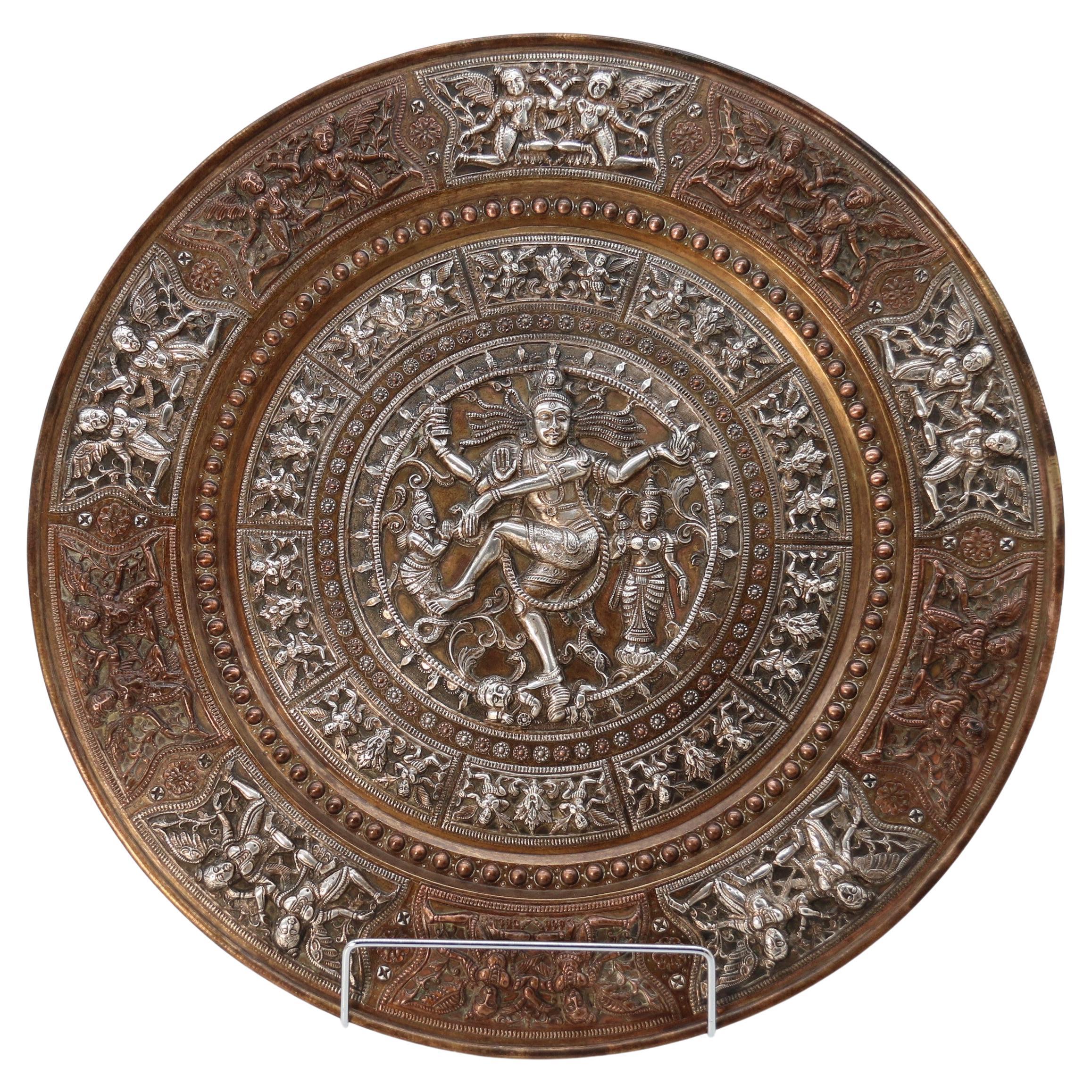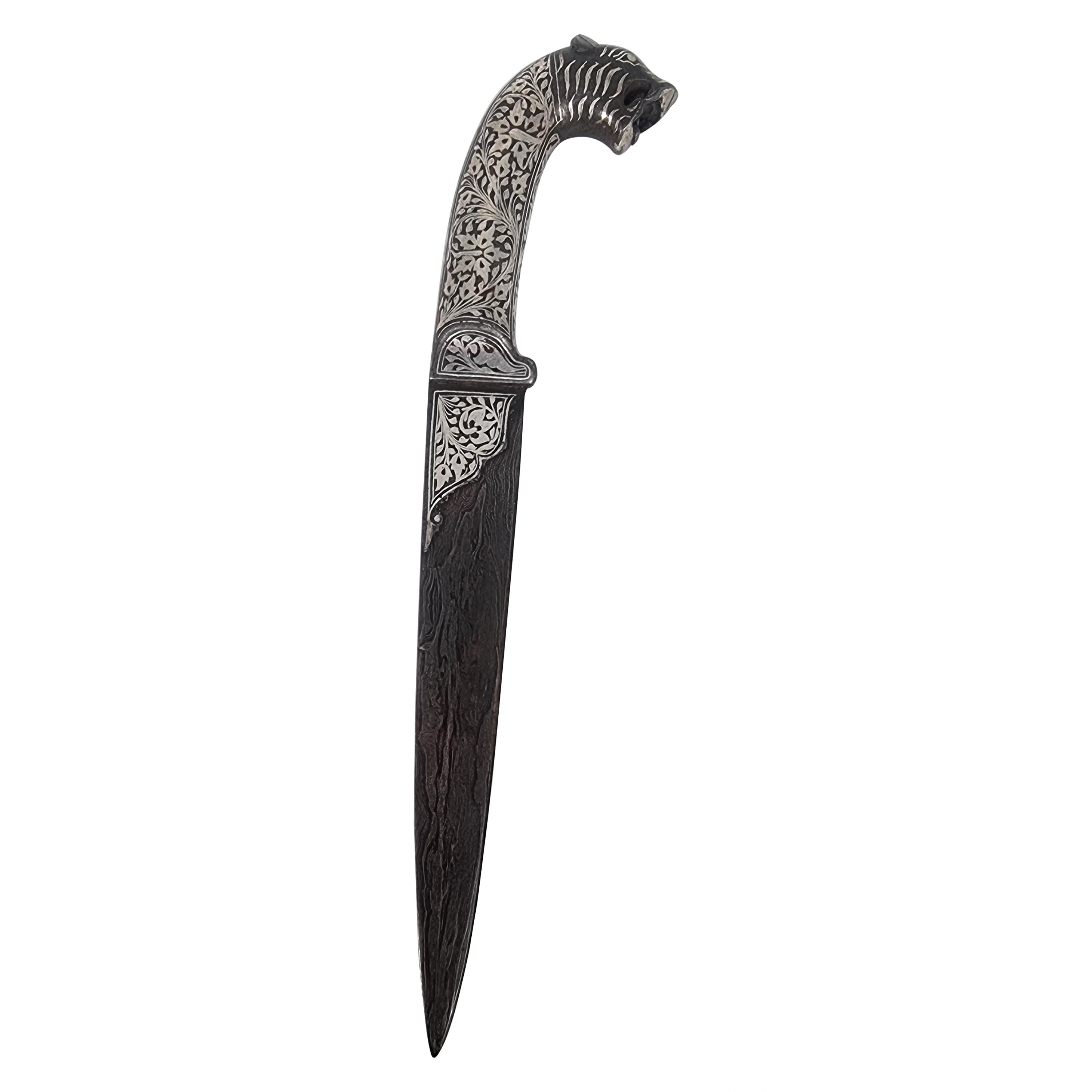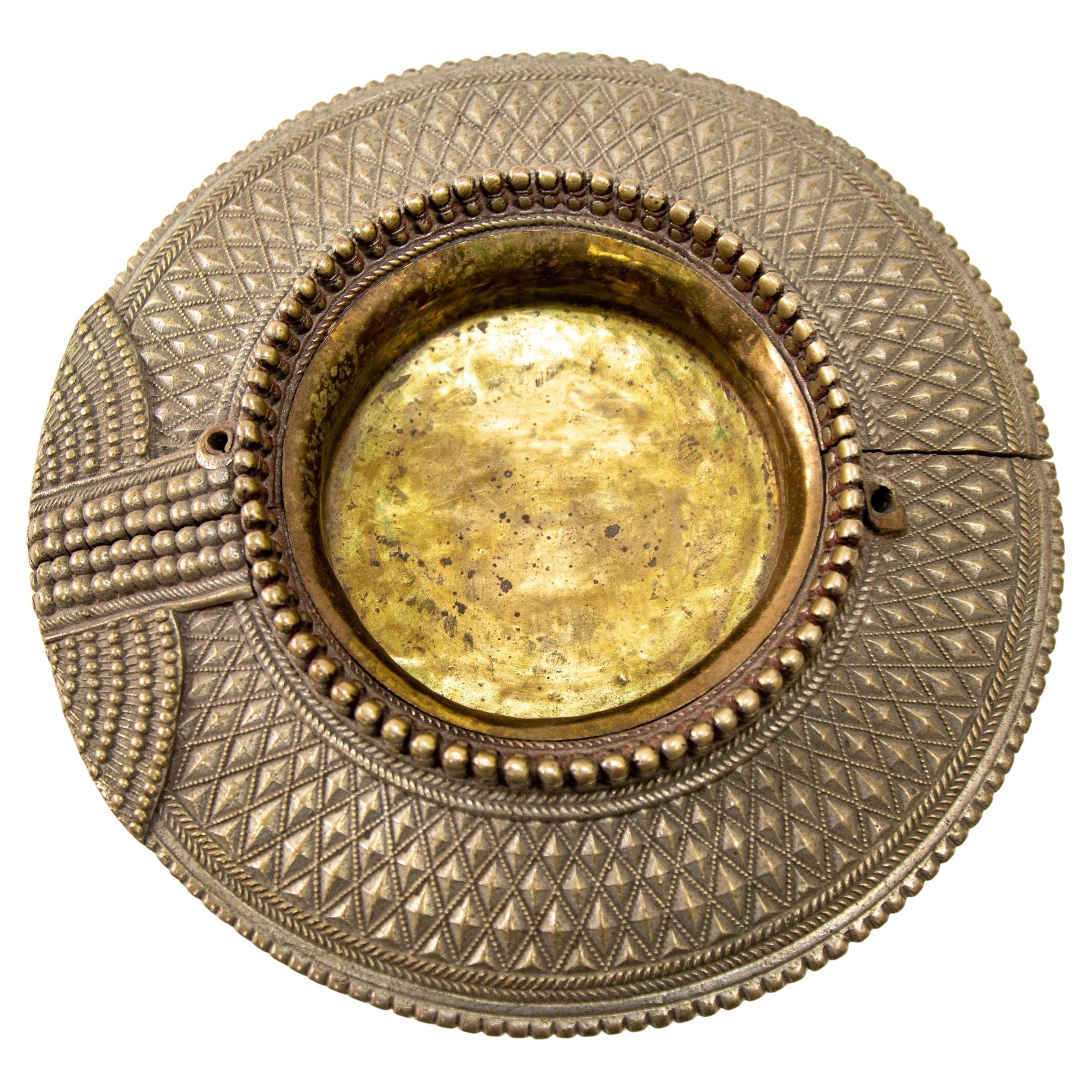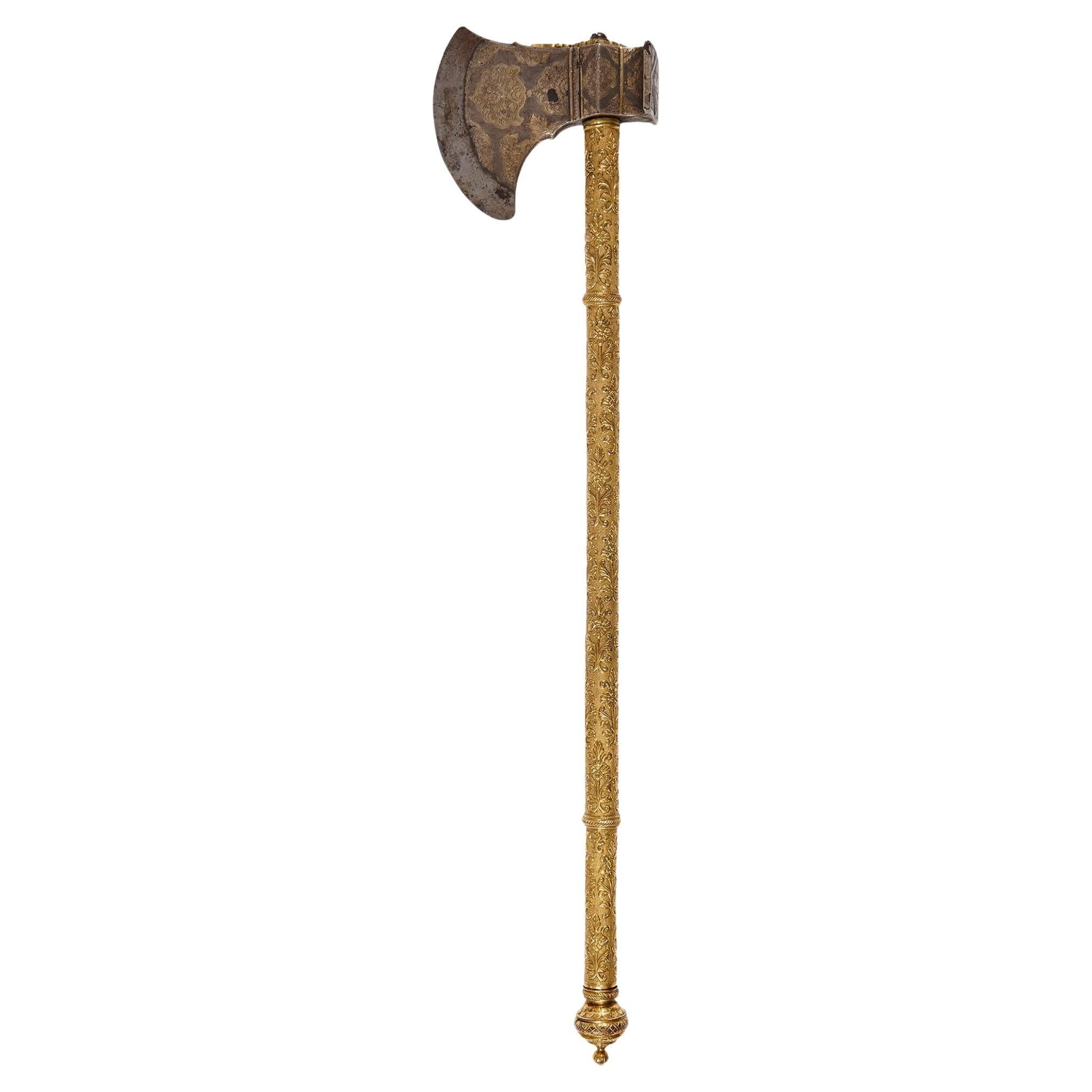Items Similar to 19th century Indian silver Raj period deep relief repousse work bowl circa 1870
Want more images or videos?
Request additional images or videos from the seller
1 of 21
19th century Indian silver Raj period deep relief repousse work bowl circa 1870
About the Item
This very high quality piece of impressive Raj period Indian silver is superbly decorated with three dimensional deep relief repousse work in the form of traditional male and female figures carrying out various tasks and religious customs.
The detail and depth of the decoration are very fine and rarely available. This type of decoration is completely hand worked using chisels and punches working from both the inside and outer surfaces to produce this amazing work of art which is finished with deep carved engraving throughout the figurative centre with a boarder of acanthus leaves above and below. The underside of this impressive bowl is decorated with an engraved peacock.
The silver from which the bowl is made tests as high grade.
Indian, circa 1870
Height 12cm x width 18.5cm x depth 18.5cm
We hope you have enjoyed looking at this fine piece of Indian art. Please let us know if you need any further information or photographs. We are more than happy to help.
- Dimensions:Height: 4.73 in (12 cm)Width: 7.29 in (18.5 cm)Depth: 7.29 in (18.5 cm)
- Style:Other (Of the Period)
- Materials and Techniques:Silver,Repoussé
- Place of Origin:
- Period:
- Date of Manufacture:1870
- Condition:Wear consistent with age and use.
- Seller Location:Central England, GB
- Reference Number:1stDibs: LU6434238706342
About the Seller
No Reviews Yet
Vetted Seller
These experienced sellers undergo a comprehensive evaluation by our team of in-house experts.
Established in 1984
1stDibs seller since 2022
14 sales on 1stDibs
Typical response time: 11 hours
- ShippingRetrieving quote...Ships From: Central England, United Kingdom
- Return PolicyA return for this item may be initiated within 14 days of delivery.
More From This SellerView All
- A Raj period silver, copper and brass repousse work charger, Indian circa 1900Located in Central England, GBThis very fine quality late 19th century Raj period charger is made from heavy gauge brass which is extensively hand decorated with exceptionally fin...Category
Early 20th Century Indian Anglo Raj Metalwork
MaterialsSilver, Brass, Copper
- A 19th century Indian silver inlaid dagger with a Damascus steel blade, C 1870Located in Central England, GBA fine 19th-century ornate Indian dagger superbly made from hand forged folded steel known as Damascus which shows on the blade with a pattern almost like wood grain. The whole knife is made from solid steel and the handle is most elaborate with a curved grip which terminates in a tiger’s head all of which is profusely inlaid with finely cut silver in foliate patterns and panels with realistic markings to the tiger's head. This fine and interesting antique knife would be a good addition to any collection or would be very useful on a desk as a paper or letter opening knife. Some history on the Damascus steel: The history of Damascus steel can be traced all the way back to 500 A.D. when in India it was called Telangana, Wootz or Ukku steel. It then found its way to Damascus, Syria, which was the centre of trade in that region for war equipment such as knives, swords and armour. The name “Damascus” wasn’t adopted until the time of the Crusaders. The Crusaders witnessed Damascus swords...Category
Antique Late 19th Century Indian Anglo Raj Metalwork
MaterialsSilver, Steel
- A Raj period Indian carved and framed deep relief hardwood wall panel circa 1880Located in Central England, GBThis superb deep relief carved hardwood Raj period Indian wall panel has its original hardwood carved frame. It is an interesting and special piece....Category
Antique 19th Century Indian Anglo Raj Decorative Art
MaterialsHardwood
- 19th Century Indian Raj Period Copper and Brass Plaque circa 1880Located in Central England, GBA 19th C Indian Raj Period Plaque This finely crafted raised and chased Indian Raj period copper and brass plaque has an intricately worked central panel depicting Nataraga, the g...Category
Antique 19th Century Indian Anglo Raj Decorative Art
MaterialsCopper
- Antique pair of mid 19th century Raj period Indian ceremonial bowls circa 1860Located in Central England, GBThis highly decorative pair of mid 19th century Raj period Indian ceremonial bowls is very unusual. They are made from dense red hardwood turned by hand on a simple pole lathe and th...Category
Antique 19th Century Indian Anglo Raj Decorative Bowls
MaterialsBrass
- 19th century Chinese bronze cencer with Buddhist lion decoration circa 1860Located in Central England, GBThis large Chinese bronze censer dates to circa 1860. It is made in three parts, stand, vessel, and lid. The lid has pierced decorative panels with pine trees and a bold Buddhist lion finial for lifting. The censer has lifting handles in the shape of bamboo to each side and again also has panels with pine forests with mythical beasts and side mounts in the form of Buddhist lion mastheads. It is raised on four shaped legs with a beast mask head at the top and sits on the raised and pierced stand. The decoration on this piece is all hand finished with chasing and engraving giving good detail. The censer has a green/brown patina. Circa 1860 Censers are a type of vessel for burning incense. In many cultures burning incense has spiritual and religious connotations which influence the design and decoration of the censer. The lion is one of Buddhism’s most potent symbols. Traditionally the lion is associated with regality, strength and power. It is therefore an appropriate symbol of Buddha who, tradition has it, was a regal prince. As Buddhist priests and monks from India, they brought with them stories of stone Asiatic lions...Category
Antique Mid-19th Century Chinese Chinese Export Metalwork
MaterialsBronze
You May Also Like
- Chinese Export Silver Repousse Scenic Box by Wang Hing, circa 1870By Wang Hing & Co.Located in Gainesville, FLChinese export silver repousse scenic box, depicting traditional scene of a mandarin riding his horse on the cover. The sides are decorated with stylized plant pattern. Marked "90" f...Category
Antique 19th Century Chinese Other Metalwork
MaterialsSilver
- 19th Century Mughal India Raj Style Silver Traditional Anklet Bracelet CatchallLocated in North Hollywood, CALate 19th century Mughal Indian Raj Style Silvered Traditional Anklet Bracelet from India repurposed as a vide poche, catchall, bowl ashtray or just as a beautiful collectible decorative object from India. Antique silver coin and brass heavy metal Dhokra ethnic tribal ankle bracelet that has been repurposed with a brass inner plate that was later added to use the bracelet as a small ashtray or decorative vanity jewelry bowl. The closure was a push pin mechanism that was closed. Dhokra art old ethnic tribal brass traditional ankle bracelet from India, handcrafted of a hollow band of heavy brass decorated with chevron repoussé banding and lost wax granulation. Measures: Height : 1.5 inches. Length : 7.5 inches. Width : 7.5 inches. Diameter: 7.5 inches Brass silver plated. Rare collectible decorative bowl, catchall, ashtray, Mughal Raj style, North India, Rajasthan. Circa 1900's Weight= 2 Lb 6.9 oz Anklets were important components in a suite of jewels worn by women in India. These very heavy examples are fabricated in two pieces, and tightly secured with a near-invisible pin. Some legends suggest that heavy anklets like these could weigh up to 20 pounds and were used to prevent brides from running away from their new families. How it is made: "Dhokra is an ancient folk art tradition prevalent in India in the eastern states of West Bengal, Odisha, Jharkhand and Chhattisgarh. Dhokra craft objects are made through the process of non-ferrous metal casting using the lost-wax casting technique, which is one of the earliest and most advanced methods of metal casting known to human civilization. Its roots can be traced back 4500 years to the ancient city of Mohenjodaro in the Indus Valley Civilization. The name Dokra or Dhokra was used to indicate a group of craftsmen of nomadic type from the Dhokra Damar tribe, scattered over the regions of Bengal, Orisa and Madhya Pradash, whose wares were identified by their beautifully shaped and decorated metal products. The enchanting Dhokra art objects have motifs inspired by indigenous folk...Category
Antique Early 1900s Indian Islamic Metalwork
MaterialsSilver Plate, Brass
- 19th Century Anglo Indian Solid Silver small Bowl hand made with chased DietiesLocated in Lincoln, LincolnshireThis is a solid silver Anglo-Indian bowl decorated with seated Dieties and made in India in the late 19th century, circa 1880. The small circular bowl is made of solid silver and has a low foot. The bowl has been beautifully hand chased with seated Dieties in different poses within circular panels which form a continuous pattern around the bowl set between a flower and leaf motif, with a lower border below the figures. The bowl weighs 79 gram. Overall, a beautiful antique solid silver bowl.Category
Antique 19th Century Indian Anglo-Indian Metalwork
MaterialsSilver
- Tabarzin, Indian Saddle-Axe from Bikaner, 19th CenturyLocated in London, GBA Tabarzin, Indian saddle-axe from Bikaner, 19th century Indian, 19th century Measures: height 56cm, width 12.5cm, depth 4cm This magnificent piece is a tabarzin, a battle saddle-axe, made in North West India in Bikaner sometime in the early nineteenth century. The head of the axe is engraved with intricate floral motifs, the handle superbly decorated with an ornate chased gilt pattern along its length. Dense and beautiful floral scroll patterns line its length, and the base unscrews to reveal a stunning hidden dagger, that is approximately a third of the axe's length. Pieces such as these are Indo-Persian, heavily indebted to Persian tabar axes, and comparable examples are to be found in the Victoria & Albert Museum in London and in the Wallace Collection, London. A remarkable item of military history...Category
Antique 19th Century Indian Other Metalwork
MaterialsGold, Silver, Steel
- 19th Century Indian Bidri Metal Hookah BaseLocated in London, GBThis fascinating piece dates from the 19th century in India, where it was used as a water base for a hookah, or shisha pipe. In traditional hookah smoking, the base of the pipe is no...Category
Antique 19th Century Indian Metalwork
MaterialsMetal
- Japanese Silver Repousse Iris Vase Meiji PeriodBy Samurai ShokaiLocated in Gainesville, FLJapanese silver repousse vase finely decorated with blown out iris flowers. It is of the Meiji period, circa 1890s. The vase is 5 1/4" tall and weighs 4....Category
Antique 19th Century Japanese Metalwork
MaterialsSilver
Recently Viewed
View AllMore Ways To Browse
Middle Eastern Dallah
Tanto Sword
Meiji Incense
Articulated Bronze Lobster
Mid Century Outdoor Set
Branching Wall Light
Large Mid 20th Century Modern Mirrors
Art Deco Dining Room Ceiling Lamp
Table And Chairs Handmade
Aged Vintage Leather Armchair
Antique Rectangular Side Table
Classical French Vase
Glass Plate Gold Plated Enamel
Jewelry Vanity Box
Black Leather Danish Lounge Chair
Lamp Ceiling 30
Wall Lamp Sphere
Light Wood Frame Armchair





